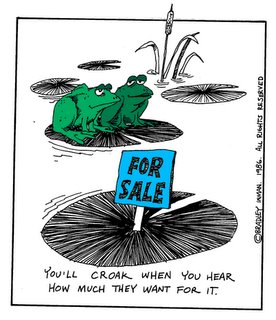
In today's real estate market, you are more likely to face competition from a slowing market and other sellers who want to cash in on their extraordinary home price appreciation. If you over price your home in this market, you will be lucky to receive any offers at all. Worse yet, you risk a downward spiral and monetary free-fall.
Seller Rational One: Price it a little too high to allow some negotiating room. The truth is that buyers won't make an offer, if they think the listing price is too high. Most buyers will not waste their time or commit to an emotional involvement for a listing that is over-priced. Over pricing indicates to a buyer that a seller has unrealistic expectations, is not serious, or will be very difficult to deal with.
Bottom Line: Buyers don't need to deal with an unrealistic seller, when there are other listings to choose from?
Seller Rational Two: Our home is nicer than those others down the street. It is very difficult to be objective about the value of your home. However, it is not difficult for the buyer to be objective about its value. Upgrades, decorator items, new roofs and mechanical systems have very little impact on a home's sales price. The buyer considers location and price, first, and the homes' condition, second.
Bottom Line: Price per square foot is the only real factor when pricing your home. If your home is priced higher per square foot than the competition, the buyer will never get out of their car to see your home's upgrades.
Seller Rational Three: We can always lower the price. After your home sits on the market a month or two without a nibble, buyers could care less, even after you correct the price. Everyone looks for a property that is in high demand and will likely have a good resale value. The longer it sits, the bigger the risk that it develops a negative stigma.
Bottom Line: A house that sits on the market, while others sell, becomes a White Elephant. Everyone asks, "What is wrong with that house?" Sadly, it's usually just the price.
Seller Rational Four: My neighbor got that much money for their house just a few months ago. The real estate market is an ever changing dynamic marketplace. In many cases, sellers are no longer in control of the market, as they were a couple of months ago. As the market softens, as it has in many areas, you may have to make further price concessions. Comparable sales from a few months ago may be out of date. If your neighbors house sold for an exceptional price, it may have been the only game in town at the time.
Bottom Line: Buyers tend to gravitate toward new listings, not ones that have been on the market for months, with sellers that are forced to cut their price to be competitive.
Seller Rational Five: Too bad, that's the price we want/need for our home. Sorry, but we are not buying it. Buyers will not overpay for something as costly as a home, when better choices are out there. Well-priced listings will come on the market and sell, while yours sits and becomes stale. When you reluctantly drop the price, buyers will think something is wrong with your house. Months later, you will have to drop your price even further, to attract the bargain hunters. Thus goes the downward housing spiral.
Bottom Line: Buyer's agents are using your over-priced home to help them sell the well-priced listings that come on the market.
Conclusion: An over-priced home listing will sit on the market. The longer the house sits unsold, the less it is worth. Use recent comparable sales and know your competition. Price your home in the market and it will move. Don't...and it won't.






